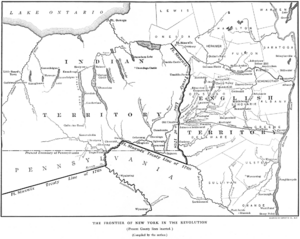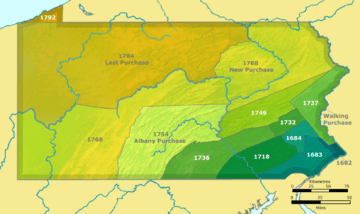Treaty of Fort Stanwix (1768) facts for kids

A portion of the 1768 Fort Stanwix Treaty line, showing the boundary in New York
|
|
| Type | Land boundaries |
|---|---|
| Signed | 5 November 1768 |
| Location | near modern-day Rome, New York |
| Signatories | Sir William Johnson |
| Parties | |
| Language | English |
The Treaty of Fort Stanwix was an important agreement signed in 1768. It was made between the Iroquois (a group of Native American nations) and Great Britain. Representatives from the colonies of New Jersey, Virginia, and Pennsylvania were also there.
The treaty was signed at Fort Stanwix, which is near modern-day Rome, New York. Sir William Johnson, a British official, helped negotiate it. This agreement set up a clear boundary line for land. It gave a large area of land, including parts of what are now Kentucky and West Virginia, to the British Crown. The treaty also settled land claims between the Iroquois and the Penn family in Pennsylvania. This newly acquired land was called the "New Purchase."
Contents
Why the Treaty Was Needed
The main goal of the Fort Stanwix conference was to update a land boundary. This boundary had been set in 1763 to separate Native American lands from the Thirteen Colonies. The British government hoped a new line would stop fighting. There was a lot of violence between Native Americans and American colonists on the frontier.
Native Americans also wanted a new, lasting boundary. They hoped it would prevent colonists from taking more of their lands. Everyone wanted to find a way to bring peace to the frontier.
Signing the Agreement
The final treaty was signed on November 5, 1768. One person from each of the Six Nations signed it. Representatives from New Jersey, Virginia, and Pennsylvania were also present. The Native American nations received many gifts and a large sum of money. This was the biggest payment ever made by the British to Native Americans.
The treaty created a "Line of Property." This line extended much farther west than the old boundary. It ran near Fort Pitt and followed the Ohio River. This effectively gave the British Crown control over the Kentucky area of the Virginia Colony. It also included most of what is now West Virginia.
Disagreements and Future Conflicts
Even though the Six Nations agreed to the treaty, not all Native American groups did. The Shawnee did not agree to this treaty. They continued to fight against colonial settlements in the Ohio area. This led to a conflict called Lord Dunmore's War in 1774.
The Six Nations had claimed ownership of land as far south as the Tennessee River. They used this area for hunting. However, other Native American groups, like the Shawnee and Delaware, actually lived on these lands. They were present at the negotiations but did not sign the treaty. The Iroquois hoped that by giving up lands in Ohio, they could protect their own home territories in New York and Pennsylvania. Instead of bringing peace, the treaty helped cause more fighting along the Ohio River.
The New Purchase in Pennsylvania
The treaty also settled land claims between the Six Nations and the Penn family. The Penn family owned the colony of Pennsylvania. The lands they gained in 1768 were known as the "New Purchase."
There were some arguments about the exact borders of this new land. It took another five years to fully agree on the final line. The last part of the boundary in Pennsylvania was set in 1773. Representatives from the Six Nations and Pennsylvania met at a place called Canoe Place. This spot is where the West Branch of the Susquehanna River meets Cush Cushion Creek.
More Land Deals
As more American settlers moved west, people became interested in land beyond the Appalachian Mountains. Investors and land speculators saw chances to make money. Because of this demand, colonial leaders sought more land from the Iroquois and Cherokee.
Another treaty, the Treaty of Lochaber, was signed with the Cherokee in 1770. This treaty changed boundaries that had been set earlier. The Cherokee gave up their claim to parts of what is now southern West Virginia.


